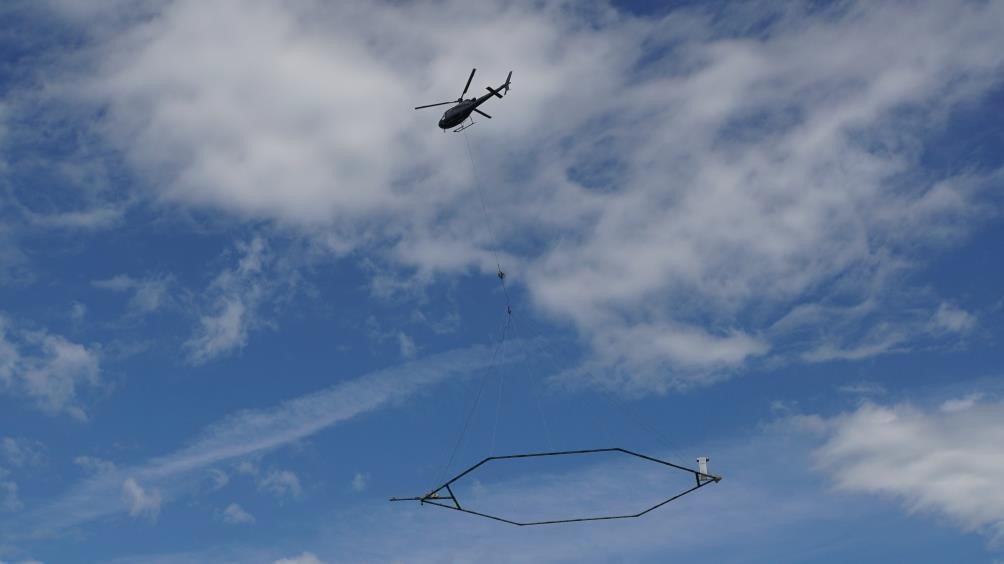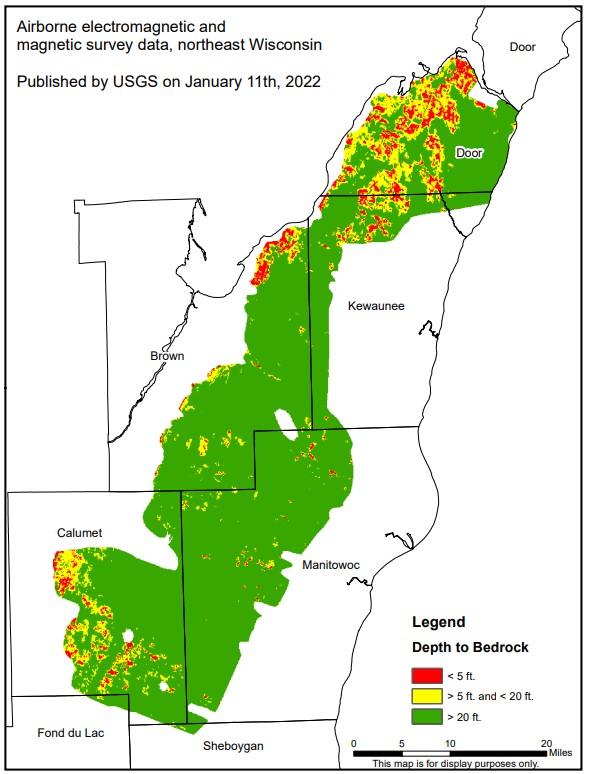Who was involved? 
The U.S. Geological Survey (USGS) conducted this scientific research project in partnership with the following:
- Wisconsin Department of Agricultural, Trade and Consumer Protection (DATCP)
- Wisconsin Department of Natural Resources (DNR)
- Wisconsin Geological and Natural History Survey (WGNHS)
What was the survey?
The survey used airborne electromagnetic (AEM) technology to update depth to bedrock maps for areas in northeastern Wisconsin. The data provided a depth to Silurian/Karst bedrock contours that updated existing map information. The use of a helicopter-towed AEM sensor (looks like a large hoop hanging from a cable) for this type of evaluation was new and provided accurate science-based data about below ground properties that are otherwise difficult to assess over large areas. This project was in response to public feedback that cited groundwater quality, limited data on depth to bedrock, and an interest in further defining aquifer properties relating to surface activities.
When did it happen?
Flights took place in early January 2021 in the following counties: Brown, Calumet, Door, Fond du Lac, Kewaunee, Manitowoc, and Sheboygan.
Why is measuring the depth to bedrock important for water quality?
The project was a result of the technical standard to support implementation of Wis. Admin. Code NR 151.075 - Silurian bedrock performance standards . The technical standard identifies science-based methods for measuring depth to bedrock and serves as a resource for landowners who mechanically apply manure to cropland. Under NR 151.075, farmers cannot apply manure mechanically to cropland where the depth to Silurian bedrock is two feet or less and other restrictions apply for depths 20-feet or less. Because Silurian is a type of bedrock that allows materials to pass through it more easily, this rule and technical standard work together to help prevent potential pathogens (disease causing organism) from reaching groundwater.
How does this information help you?
This survey supports public health efforts to help protect groundwater from potential pathogens and promote water quality. The results of the survey will:
- Reduce the financial burden on private landowners to verify existing maps
- Create a better understanding of aquifer properties
- Provide accurate information to farmers to help them avoid mechanical manure applications in very shallow depth to bedrock areas
This project used the strength of local, state, and federal resources to help many citizens in the northeastern part of the state.
Survey Area

Future Flights
Additional AEM flights in 8 southwestern and southeastern Wisconsin in February and March 2022. For more information about these flights: https://www.usgs.gov/centers/upper-midwest-water-science-center/science/airborne-electromagnetic-aem-survey-2022.
Additional Information
General footage of the surveying equipment: https://www.youtube.com/watch?v=qSTddN9njuk
Example of how to view and use the data: https://www.youtube.com/watch?v=6fbCZLgQPl8
Contacts
This project was a multi-agency partnership. Contact the appropriate area below based on the topic of your question.
General
| DATCP
| DATCPlandwater@wi.gov
| NA
|
NR 151 or associated compliance requirements
| DNR
| Joe Baeten
| (920) 366-2072
|
Verification of depth to bedrock standard
| DATCP
| Rachel Rushmann
Matt Woodrow
| (608) 590-7357
(920) 427-8505
|
AEM survey and flight paths
| USGS
| Matt Komiskey
Burke Minsley
| (608) 235-0621
(303) 236-5718
|
Calibration line for the AEM survey
| WGNHS
| Dave Hart
| (608) 262-2307
|